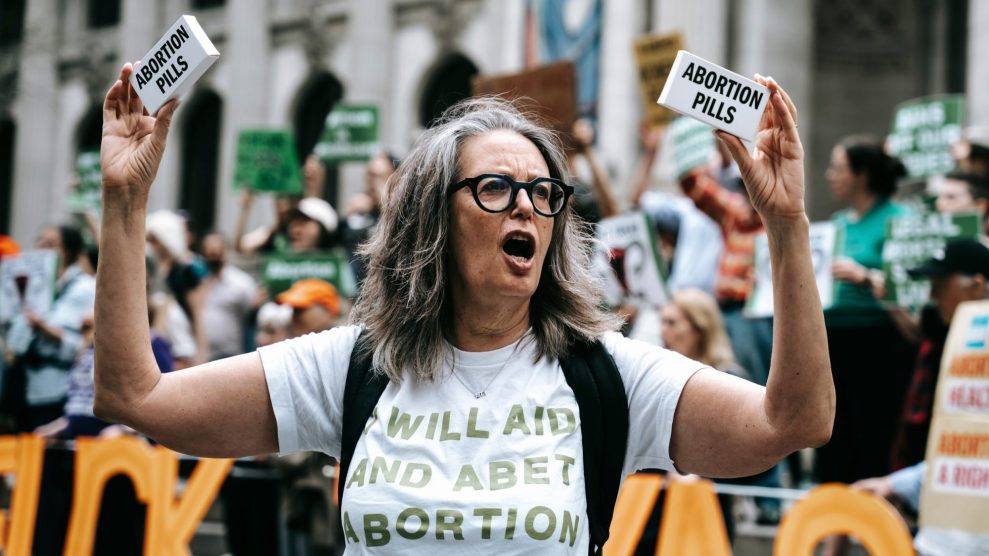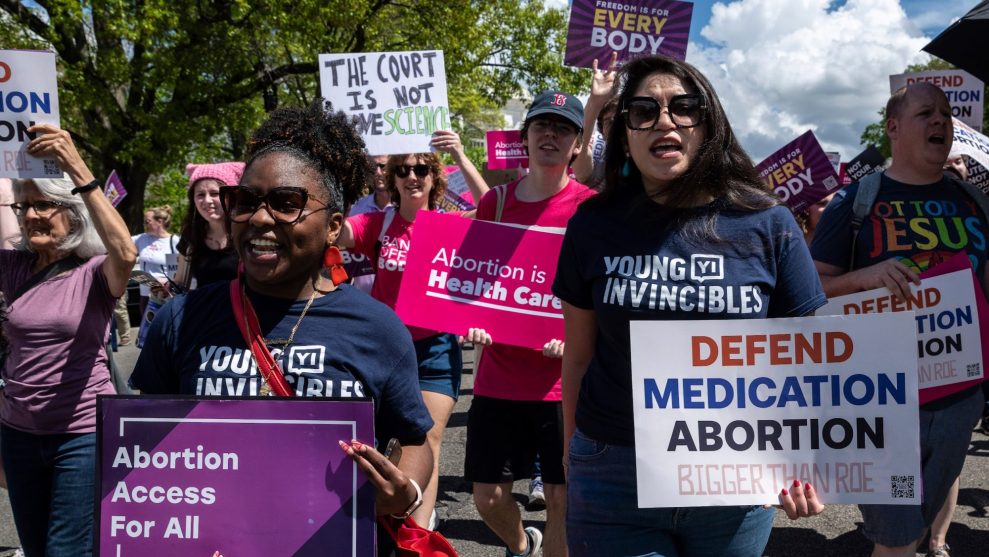
When the Supreme Court hears oral arguments next week in the case seeking to restrict the availability of mifepristone, they'll also hear baseless claims from the anti-abortion side about the role of telehealth abortion in facilitating intimate partner violence.Olga Fedorova/SOPA/Sipa/AP
Next week, the Supreme Court will hear oral arguments in the case brought by anti-abortion activists seeking to restrict the availability of mifepristone, the first of the two pills taken in a medication abortion.
The basis of the arguments against the pill rests on myriad falsehoods, which have already been disproven: Contrary to anti-abortion activists’ claims, more than 100 studies have shown that medication abortion—which accounts for more than half of all abortions nationwide, according to the Guttmacher Institute—is safe and effective. That includes a study published in February in the journal Nature Medicine that found medication abortion is just as safe when it’s prescribed virtually as it is in person, as I reported at the time.
But there’s another, lesser-reported piece of misinformation that anti-abortion activists are peddling before the high court. They’re alleging that the availability of telehealth abortions—in which providers prescribe the pills by phone or video call and then mail them to patients—harms people experiencing intimate partner violence by enabling abusers to force people to have abortions. This could potentially impact how the Supreme Court rules on whether the FDA acted improperly in 2016 and 2021, when the agency relaxed some rules around how mifepristone can be prescribed—including allowing it to be prescribed virtually and sent by mail. Versions of this narrative—that telehealth abortion facilitates abuse—are present within 9 of the more than 80 “friend of the court” briefs (which also include arguments for preserving mifepristone) filed in the case, according to my review. These briefs are essentially statements of interest from parties—individuals or organizations—who are not part of the court case but are seeking to influence the court’s decision.
And like many arguments from the anti-abortion side, the claim that medication abortion prescribed through telehealth contributes in any significant way to domestic abuse is baseless: Experts told me it’s unsupported by evidence and ignores many of the ways reproductive coercion actually manifests—as well as the many benefits telehealth abortion can provide for people experiencing intimate partner violence.
But making up their own facts is nothing new to anti-abortion activists. Two studies that claimed to show the dangers of mifepristone and were cited in the Texas court ruling that led to the forthcoming Supreme Court case were retracted in February after an independent peer review uncovered unsupported conclusions due to flaws with the study design, methodology, and data analysis—along with possible conflicts of interest given the lead author’s affiliation with the Charlotte Lozier Institute, an anti-abortion advocacy organization.
“There’s no basis in facts or medical science for any parts of this case,” Elisa Wells, co-director and co-founder of Plan C, a campaign focused on medication abortion access, told me. And the risks of intimate partner violence that the anti-abortion side claims to worry about in their briefs, she added, “are created by the abuser—not by telehealth abortion.”
One of the main claims in the anti-abortion briefs is that the majority of abortions are coerced, and that telehealth abortions—which now account for up to sixteen percent of all abortions nationwide—help perpetuate coercion by making it easier to terminate a pregnancy and harder for providers to screen for signs of coercion.
But Diana Greene Foster, a professor at the University of California, San Francisco, told me that it’s “extremely rare” for people to be coerced into abortion—and that it’s far more common for people to report being coerced into pregnancy by an abusive partner. One of Foster’s papers, based on more than 5,100 women seeking abortions at one clinic in 2008, found that only one percent of respondents said they were seeking an abortion because someone else wanted them to get one, with minors feeling more likely to report feeling pressured than adults. Another paper Foster co-authored, published in 2013, found that most people seeking abortions do so for multiple reasons, and that the top ones include financial reasons, timing and partner-related reasons, including not having a stable relationship or wanting to be married first.
“Most abortion patients are not being coerced,” Foster said. “They are making the decision for themselves based on their own life circumstances.”
Rebecca Gomperts, a physician and the founder of Aid Access, which provides telehealth abortions across the country, agreed. While she said Aid Access “regularly” hears from pregnant people dealing with partners trying to force them to keep the pregnancy, she added that they’ve “never seen the other way around, where a women is forced to have an abortion against her will.” Gomperts shared with me via e-mail a note from a client who reached out to Aid Access after her boyfriend tracked her down at a local Planned Parenthood—where she had gone to obtain an abortion—and brought her home; notes from two other clients she shared with me thanked the service with helping them leave abusive relationships.
As the National Domestic Violence Hotline points out in its own friend of the court brief arguing for the preservation of the FDA approval of mifepristone, “traveling for abortion care may not be an option, and having options for discreetly accessing abortion care helps survivors maintain safety and privacy.” The costs of travel and childcare can also be “prohibitive” for people experiencing financial abuse, that brief adds. And as several other briefs filed by reproductive rights organizations note, medication abortion can help survivors of intimate partner violence avoid unwanted physical contact in a doctor’s office, which may be a priority for some based on their past experiences of abuse.
And because an abortion at home “appears very much like a miscarriage,” it’s unlikely to attract the level of scrutiny that traveling to an in-person abortion may bring from an abusive partner, according to Ondine Quinn, the director of program development at Provide, an organization that trains advocates for people experiencing domestic and sexual violence on how to help survivors safely access medication abortion.
But you don’t get this sense from the briefs filed by the anti-abortion side—several of which paint sinister pictures of abusers regularly lurking behind phones and computer screens and abusing telehealth abortions by forcing pregnant people to obtain them against their will while providers remain oblivious. There’s the brief from the Charlotte Lozier Institute, which says, for example: “With limited visibility and an inability to detect unspoken body language, there is no way to ensure that an abuser standing off-screen is not pressuring the woman to request an action that she does not desire.”
Experts say that while such a scene is theoretically possible, these arguments also ignore the fact that coercion can also occur during in person health care appointments, where abusive partners can insist on being present. “That’s the nature of the controlling relationship,” according to Liz Tobin-Tyler, an associate professor of health services, policy, and practice at Brown University who has written about the interactions between abortion restrictions and intimate partner violence. And health care providers aren’t necessarily always screening for intimate partner violence even when they do see patients in person: A literature review of 35 studies published in the journal Trauma, Violence & Abuse in 2016 found that “overall, health-care workers remain challenged in screening and appropriately responding to IPV.”
It’s also possible for telehealth abortion providers to make efforts to screen for intimate partner violence by phone or computer, Tobin-Tyler noted. She pointed me to a June 2021 paper published in JAMA by a professor of obstetrics and gynecology from Northwestern University, who argued that telehealth clinicians should ask yes or no questions—including whether patients are alone and can safely speak—to determine if a patient is experiencing intimate partner violence, and that providers should be prepared to refer patients to hotlines and other resources if necessary.
Aid Access asks clients if they are requesting medication abortion through their own free will, and asks them to submit proof of identification, Gomperts said. Hey Jane, another major telehealth abortion provider, also has “protocols in place” to screen for intimate partner violence, according to a spokesperson. A spokesperson for Wisp, a telehealth provider that provides a range of services including medication abortion, said that while the service doesn’t screen for domestic violence, they do provide resources if people disclose they’re experiencing it or other forms of abuse. Spokespeople for other major telehealth abortion providers—including Carafem, Twentyeight Health, Cambridge Reproductive Health Consultants, and Honeybee Health—didn’t respond to my requests for comment by publication time.
As I’ve written, new data in fact suggests that rising abortion restrictions will disproportionately impact people experiencing intimate partner violence—who are already more likely to be people of color, LGBTQ people, and disabled people compared to the general population.
A study published in February in the Journal of the American College of Surgeons found that, under Roe, pregnant and postpartum people in states with abortion restrictions had a 75 percent higher rate of homicide than those in states that protected abortion access; pregnant and postpartum people were also at higher risk for homicide due to intimate partner violence compared to homicide victims who weren’t pregnant. And a study published in JAMA Internal Medicine in January estimated that there were more than 64,500 pregnancies as a result of rape in 14 states with abortion bans after the Dobbs decision, with the majority—nearly 59,000—occurring in nine states with abortion bans that lack exceptions for rape or incest.
Research that shows the significance of abortion access for survivors of intimate partner violence isn’t new. A 2014 study co-authored by Foster found that women who were unable to get wanted abortions were more likely to experience “sustained physical violence” and “sustained contact” with an abuser over time, while those who were able to obtain abortions experienced less physical violence and ended their relationships with their abusive partners sooner than those who gave birth.
As Tobin-Tyler told me: “Protecting people that are experiencing domestic violence is intimately tied to their reproductive autonomy.” Whether the justices are prepared to recognize the facts that support that remains to be seen.















